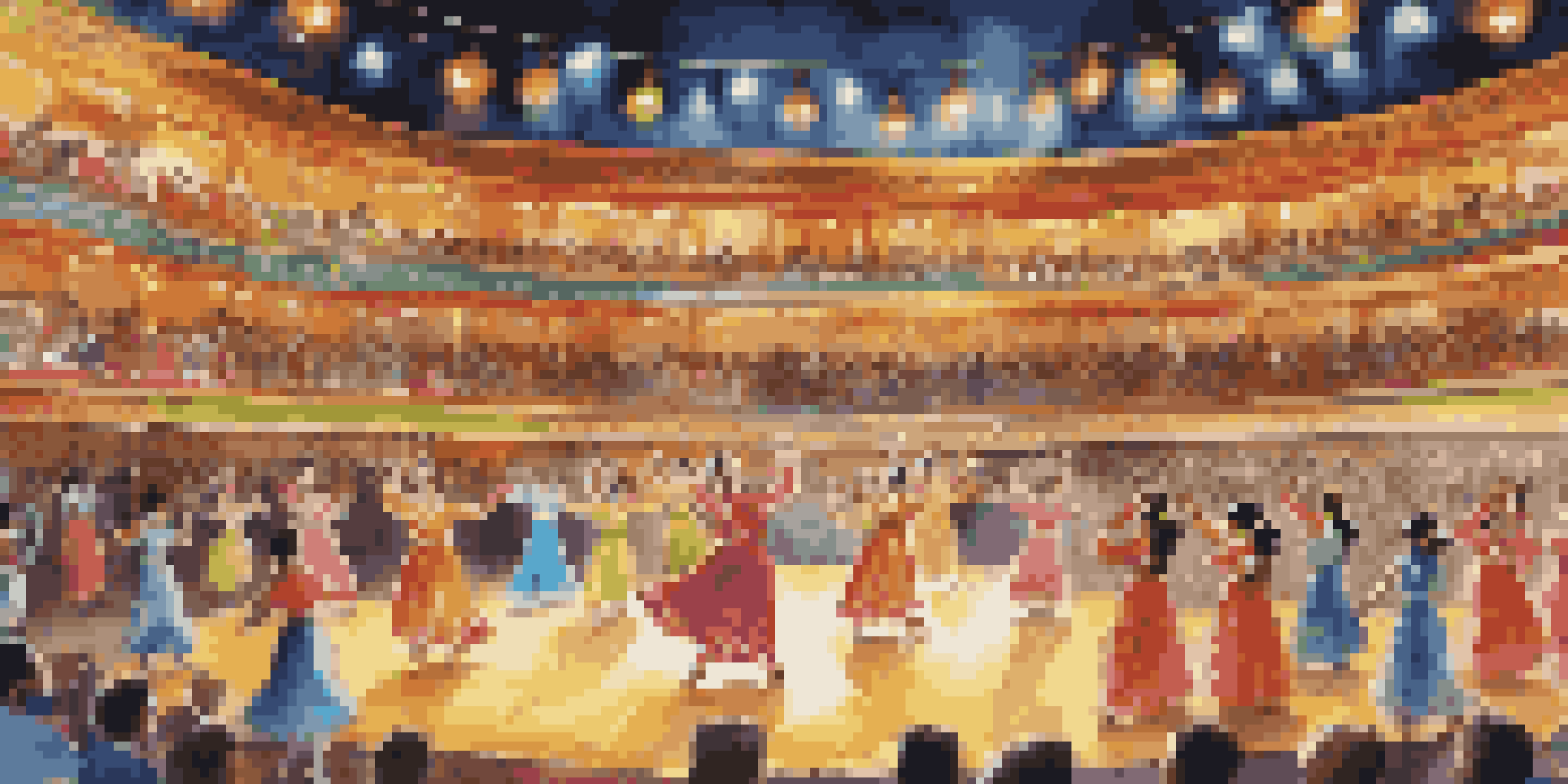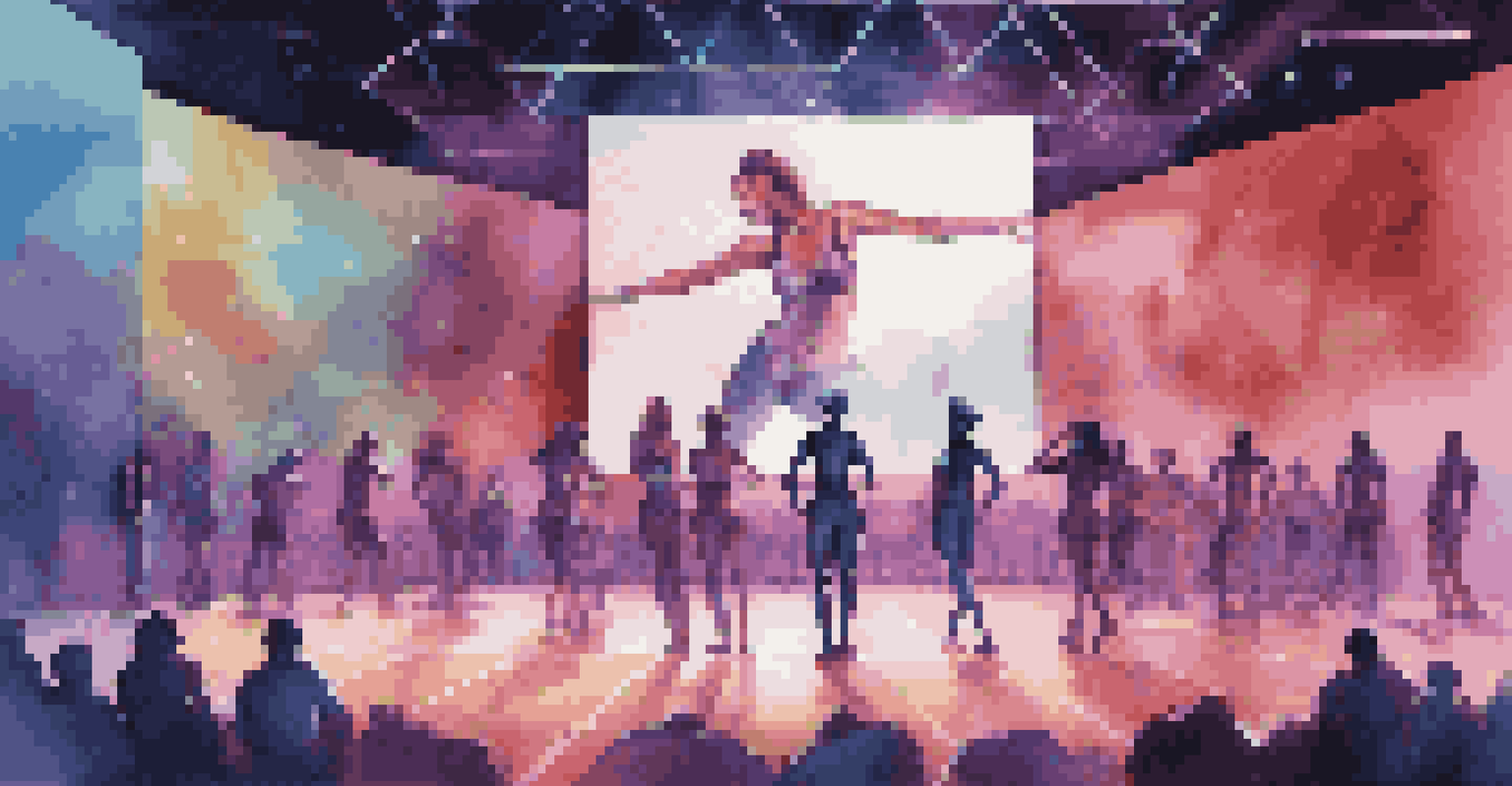The Future of Dance Competitions: Virtual vs. Traditional Formats

Understanding Traditional Dance Competitions
Traditional dance competitions have long been a staple in the dance community, bringing performers together on stage to showcase their skills. These events often create an electrifying atmosphere, with live audiences adding to the excitement and energy. Dancers typically prepare for weeks or even months, perfecting their routines in hopes of impressing judges and gaining recognition.
Dance is the hidden language of the soul.
The communal aspect of these competitions fosters a sense of camaraderie among dancers, as they share the stage and experience the thrill of performance together. Moreover, judges often provide valuable feedback in real-time, helping dancers to grow and improve their craft. The ability to connect with others in person is a significant draw for many participants and spectators alike.
However, the logistics of organizing traditional competitions can be complex, involving venue bookings, ticket sales, and travel arrangements for participants. These challenges can limit access for some dancers, particularly those in remote areas or with financial constraints. As technology evolves, many are beginning to explore alternative formats that may offer greater accessibility.
The Rise of Virtual Dance Competitions
In the wake of recent global events, virtual dance competitions have surged in popularity, offering an innovative alternative to traditional formats. Dancers can now record their performances from the comfort of their own studios or homes, sending submissions online for judging. This flexibility allows participants to choose their optimal environment for practice and filming, which can lead to improved performances.

Virtual competitions also break down geographical barriers, enabling dancers from around the world to compete against one another without the need for travel. This inclusivity opens the door for more diverse participation, as dancers who may have previously felt excluded due to distance or cost can now showcase their talents on a global stage. The sense of community can still thrive in virtual spaces, with online forums and social media connections.
Virtual Competitions Increase Access
Virtual dance competitions break down geographical barriers, allowing dancers from diverse backgrounds to participate without the limitations of travel and logistics.
Furthermore, the use of technology in virtual competitions allows for creative formats, such as themed challenges and collaborative performances. Dancers can experiment with different styles and approaches, pushing the boundaries of their art. However, some still question whether virtual competitions can truly replicate the energy and excitement of live performances.
Comparing the Experiences: Virtual vs. Traditional
When comparing virtual and traditional dance competitions, it's essential to consider the overall experience for both dancers and audiences. Traditional events often offer an exhilarating atmosphere, with live applause and the thrill of performing in front of an audience. This immediate feedback can be incredibly motivating for dancers, driving them to give their best performances.
The only way to make sense out of change is to plunge into it, move with it, and join the dance.
On the other hand, virtual competitions provide flexibility and convenience, allowing dancers to perform when they feel most prepared. The ability to edit and refine submissions before sending them can lead to polished performances that might not be possible in a live setting. Yet, some dancers may miss the adrenaline rush that comes from competing on stage.
Ultimately, the choice between virtual and traditional formats may come down to personal preference and the specific goals of each dancer. While some may thrive in the high-pressure environment of a live competition, others may find their stride in the more relaxed setting of a virtual event. Both formats have their unique advantages and challenges.
The Role of Technology in Dance Competitions
Technology plays a pivotal role in shaping the future of dance competitions, influencing everything from performance submissions to judging criteria. Advanced video editing tools allow dancers to enhance their performances, ensuring they present their best selves in virtual competitions. Additionally, streaming platforms enable competitions to reach wider audiences, breaking the confines of physical venues.
Moreover, technology can enhance the judging process by providing tools for more accurate scoring and feedback. Some competitions are leveraging artificial intelligence to analyze performances, offering insights that human judges may overlook. This can lead to more objective evaluations, although it raises questions about the human element in artistic judgment.
Blending Formats for Future Events
The future of dance competitions may see a hybrid model that combines the excitement of live performances with the convenience of virtual formats.
As technology continues to evolve, we can expect even more innovations in the dance competition landscape. From augmented reality performances to interactive audience participation, the possibilities are vast. Embracing these advancements may open up new avenues for creativity and expression in the world of dance.
Accessibility and Inclusivity in Dance Competitions
One of the most significant benefits of virtual dance competitions is their potential for increased accessibility and inclusivity. Dancers from various backgrounds, including those with disabilities or those living in remote areas, can easily participate without the barriers posed by travel and logistics. This democratization of opportunities allows for a richer tapestry of talent and creativity within the dance community.
Traditional competitions, while vibrant, can inadvertently exclude those who may not have the means to travel or the ability to participate in person. Virtual formats help to bridge this gap, creating a more diverse participant pool. This inclusivity fosters a sense of belonging and representation, encouraging dancers to express their unique styles and narratives.
Furthermore, virtual competitions often provide various categories tailored to different skill levels and styles, ensuring that everyone has a chance to shine. This focus on inclusivity not only enriches the competition but also helps to inspire the next generation of dancers. By creating spaces where all voices are heard, the dance community can thrive together.
Future Trends in Dance Competitions
As we look ahead, the landscape of dance competitions is likely to continue evolving, blending elements of both virtual and traditional formats. Hybrid competitions may become the norm, offering participants the chance to perform live while also providing virtual options for those unable to attend. This flexible approach could cater to a broader audience and accommodate various preferences.
Additionally, collaborations between dance competitions and technology companies may lead to innovative formats and experiences. Imagine virtual reality dance-offs, where judges can assess performances in a completely immersive environment, or live-streamed events that allow audiences to engage with performances in real-time from anywhere in the world. The fusion of technology and artistry could revolutionize how we experience dance competitions.
Technology Enhances Dance Experience
Advancements in technology are reshaping dance competitions by improving performance submissions, judging processes, and audience engagement.
Ultimately, the future of dance competitions will likely prioritize adaptability, creativity, and community. As dancers and organizations navigate this changing landscape, they will need to stay attuned to the needs and preferences of participants and audiences alike. By embracing both virtual and traditional formats, the dance community can continue to flourish and inspire.
Conclusion: Embracing the Best of Both Worlds
In conclusion, the future of dance competitions holds exciting possibilities as we explore the balance between virtual and traditional formats. Both have their unique strengths, and the key may lie in finding ways to integrate the best aspects of each. By doing so, we can create enriching experiences that nurture talent and foster connections within the dance community.
As dancers continue to adapt to this evolving landscape, they are encouraged to embrace the opportunities that both formats provide. Whether performing live on stage or submitting a video from home, each dancer has the chance to shine and share their passion for dance. The thrill of competition can be experienced in various forms, each offering its own set of rewards.

Ultimately, the journey of a dancer is about growth, expression, and community. As we move forward, let's celebrate the diverse ways in which dance competitions can empower and inspire dancers of all backgrounds. Together, we can shape a vibrant future for the art of dance.